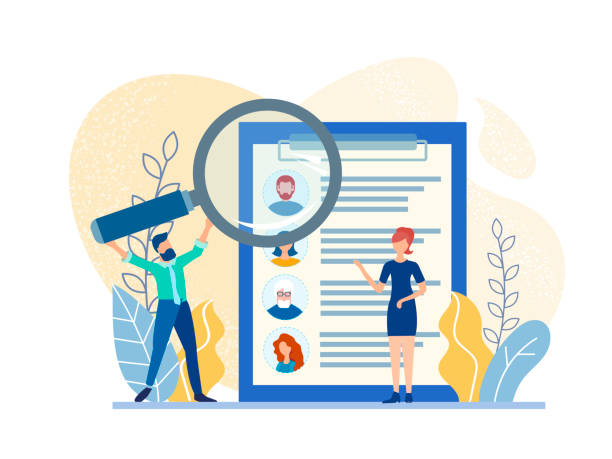Why is Designing an E-commerce Website Crucial for Your Business?
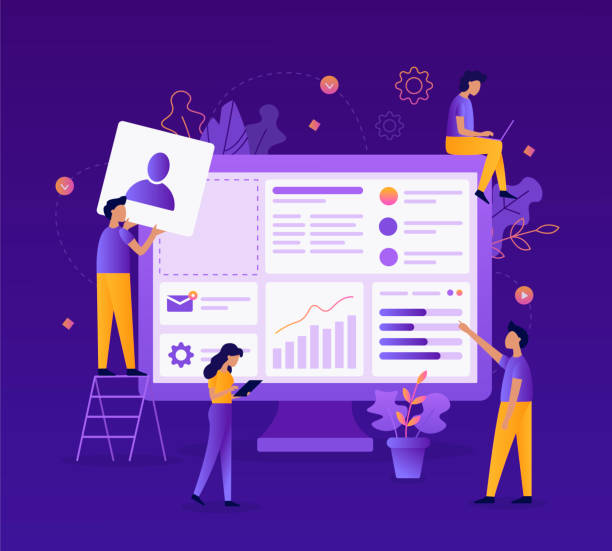
In today’s world, where the physical boundaries of business have blurred, an online presence is no longer an option, but a necessity. #eCommerce is rapidly growing, and having a strong #onlineStore is considered the beating heart of any successful business.
E-commerce website design allows you to offer your products or services 24 hours a day, 7 days a week, without geographical limitations, to customers worldwide.
This not only provides you access to a wider market but also significantly reduces operational costs compared to physical stores.
Imagine how much you can save on rent, extra staff salaries, and other fixed costs! Beyond this, an e-commerce website offers unparalleled opportunities for #onlineMarketing and direct communication with customers.
You can collect valuable data on user behavior and optimize your marketing strategies accordingly.
This optimization directly leads to increased sales and improved customer experience.
Furthermore, creating an e-commerce platform doubles your business’s credibility and professionalism in the eyes of customers. In an era where everything is moving towards digitalization, an ineffective online presence means losing a large market share.
Therefore, investing in e-commerce website design is a strategic and vital decision for the survival and growth of any business.
Tired of losing customers due to poor e-commerce website design? With Rasaweb, solve this problem forever!
✅ Increase sales and visitor-to-customer conversion rate
✅ Smooth and engaging user experience for your customers⚡ Get free consultation
Key Elements in Designing an Efficient Online Store
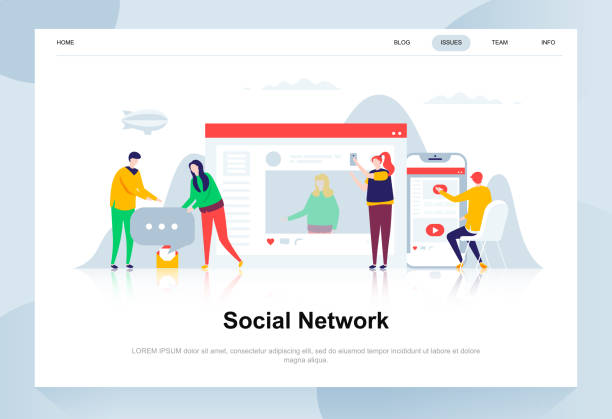
For an e-commerce website to be truly efficient and successful, beyond its aesthetic appeal, attention must be paid to numerous key elements that improve the User Experience (UX) and User Interface (UI).
The first and most important element is an attractive and user-friendly visual design that captures the visitor’s attention at first glance.
This includes a simple yet modern User Interface (UI).
Alongside this, a smooth and problem-free User Experience (UX), from finding a product to completing the purchase process, is crucial.
This means easy-to-access menus, a robust search function, and practical filters to help customers quickly find their desired products.
Product pages should include high-quality images from various angles, accurate and comprehensive descriptions, technical specifications, and customer reviews.
This complete information builds customer trust and helps them make purchasing decisions.
The add-to-cart and checkout process should also be as simple and quick as possible.
Any complexity in these steps can lead to abandoned carts and lost customers.
The ability to pay through various gateways, clear display of shipping costs and taxes, and offering diverse shipping options are other necessities.
Furthermore, inventory management, order tracking for customers, and an efficient support system (such as online chat or FAQ) all contribute to improving the overall experience.
These elements together provide the necessary foundation for a sustainable and profitable e-commerce business.
Successful e-commerce website design requires attention to detail and a customer-centric approach to convert every visitor into a loyal buyer.
Choosing the Right Platform for Your E-commerce Website Design
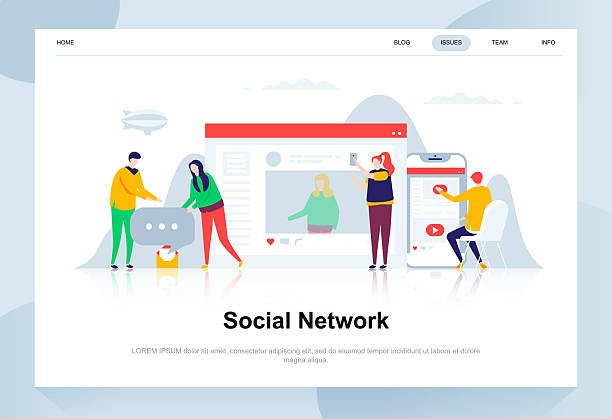
One of the most important decisions in the path of e-commerce website design is choosing the right platform.
This choice will directly impact your costs, development capabilities, ease of management, and future marketing opportunities.
Various platforms are available in the market, each with its own advantages and disadvantages.
Open-source platforms like WooCommerce, which is a WordPress plugin, offer great flexibility in customization and usually have lower initial costs, but require more technical knowledge for setup and maintenance.
In contrast, SaaS (Software as a Service) platforms like Shopify, are comprehensive solutions that include hosting, security, and updates, making them ideal for businesses with limited technical knowledge or those looking for quick setup.
Magento is also a powerful and flexible option suitable for large and complex stores with specific needs, but it comes with higher complexity and cost.
Finally, there are custom solutions, built from scratch by development teams, which are fully tailored to your unique business needs but are considered the most expensive and time-consuming option.
The correct choice depends on your budget, business scale, technical skills, and long-term goals.
Below is a general comparison of some common platforms:
| Platform | Type | Suitable For | Customization Level | Ease of Use | Approximate Cost (Annual) |
|---|---|---|---|---|---|
| WooCommerce | Open-source (WordPress Plugin) | Small to Medium | High | Medium | Low (Host & Domain) |
| Shopify | SaaS | Small to Medium | Medium | High | Medium (Monthly Subscription) |
| Magento | Open-source | Medium to Large | Very High | Low (Requires Developer) | High (Implementation & Maintenance) |
Optimizing User Experience (UX) and User Interface (UI) in Online Stores

After choosing the right platform, one of the most crucial steps in creating a successful e-commerce website is focusing on optimizing User Experience (UX) and User Interface (UI).
These two elements determine how much customers enjoy browsing and shopping on your site and how likely they are to return.
The first step is responsive design.
Given the significant increase in smartphone use for online shopping, your site must be fully viewable and usable on all devices, from desktops to mobiles and tablets.
Website loading speed is also of paramount importance; even a few seconds of delay can cause users to abandon the site.
Optimizing images, using caching, and choosing a powerful hosting service significantly help increase speed.
User Interface (UI) design should be simple, clean, and uncluttered.
Use readable fonts and appropriate color schemes that align with your brand.
Site navigation (menus and categories) should be logical and easy to use so that users can easily find the products they are looking for.
Optimizing the shopping cart and checkout process to reduce steps and remove obstacles is also very vital.
Offering diverse payment options and transparently displaying order details (final price, shipping cost, delivery time) helps increase trust and reduce cart abandonment rates.
Furthermore, including customer reviews and product ratings enhances the site’s credibility. By paying attention to these points in e-commerce website design, you can create a pleasant experience for your customers, leading to increased sales and their loyalty.
Are you dissatisfied with the low visitor-to-customer conversion rate on your e-commerce website?
With professional e-commerce website design by Rasaweb, solve this problem forever!
✅ Significantly increase conversion rates and sales
✅ Create an excellent user experience and build customer trust
⚡ Contact us now for a free consultation!
The Importance of SEO in E-commerce Website Design and Increasing Visibility

Merely designing an e-commerce website alone does not guarantee success; you must ensure that potential customers find your site in search results.
This is where Search Engine Optimization (SEO) plays its vital role.
SEO is a process that helps your site rank higher in search engines like Google, subsequently attracting more organic (free) traffic.
For an online store, SEO involves several key sections.
First, keyword research is highly important.
You need to identify the words your customers search for on Google to find similar products and strategically use them in product titles, descriptions, meta descriptions, and page URLs.
On-Page SEO involves using compelling title tags, convincing meta descriptions, optimized images with alt text, and unique, rich content.
Additionally, proper internal linking between different pages of the site helps improve search engine accessibility and user experience.
Technical SEO is also a crucial aspect, including ensuring high loading speed, responsive design, using an SSL certificate for security, and creating search-engine-friendly URL structures.
Creating high-quality and relevant content, such as blog articles about your products or industry, not only aids SEO but also increases your brand’s trust and credibility.
Ultimately, SEO is a continuous process and, due to changes in Google’s algorithms, requires constant monitoring and updating to ensure the visibility and long-term success of your online store.
Payment Security and Banking Gateways in Online Stores
![]()
One of the biggest concerns for users when shopping online is the security of financial information and payments. Therefore, when building an e-commerce website, ensuring payment security and choosing an appropriate banking gateway are top priorities.
The first step in guaranteeing security is using an SSL/TLS certificate.
This certificate encrypts the communication between the user’s browser and your website server, ensuring that sensitive information such as credit card numbers and passwords remain safe from hackers during transmission.
The presence of “HTTPS” at the beginning of the website address and a lock symbol in the browser’s address bar indicates that SSL is active and gives users a sense of security.
Regarding banking gateways, you should use reputable gateways approved by the Central Bank and Shaparak (Iran’s payment network).
These gateways are responsible for securely processing transactions and adhere to high security standards.
When choosing a gateway, pay attention to factors such as transaction fees, ease of integration with your site, technical support, and settlement speed.
Some popular payment gateways in Iran include Zarinpal, IDPay, NextPay, and direct bank gateways.
In addition to payment gateways, attention should also be paid to the overall security of the server and the site. Regular updates of the e-commerce platform, use of firewalls, regular data backups, and periodic security tests all help protect your site against cyber attacks.
Educating users about phishing risks and the importance of protecting personal information can also be beneficial. Ensuring the security of payment gateways and the entire e-commerce site not only protects customer information but also builds their trust and adds to your brand’s credibility.
Without a secure payment system, no customer will risk purchasing from your site.
Marketing and Growth Strategies After Launching an Online Store
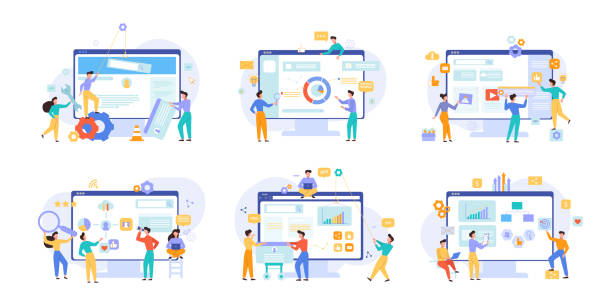
After completing e-commerce website design and launching it, the main work only just begins: attracting customers and increasing sales.
Digital marketing plays a pivotal role in the long-term success of your online store.
One of the most effective methods is content marketing.
By creating a blog, writing specialized and educational articles, and producing video content related to your products, you can attract organic traffic and convert audiences into customers.
Active presence on social media is also very important. By choosing appropriate platforms for your target audience (such as Instagram, Telegram, Twitter), you can interact with your customers, introduce new products, and run advertising campaigns.
Email marketing remains one of the most profitable channels.
Collecting customer emails and sending regular newsletters, special discounts, and reminders for abandoned carts can help increase conversion rates.
Paid Ads, such as Google Ads and social media advertisements, are a quick way to drive targeted traffic to your site.
These ads allow you to precisely target your desired audience.
To measure the success of marketing strategies, continuous monitoring of Key Performance Indicators (KPIs) is essential. These indicators include conversion rate, average order value, customer acquisition cost, and customer retention rate.
The table below shows some important KPIs:
| Indicator | Description | Importance |
|---|---|---|
| Conversion Rate | Percentage of visitors who make a purchase. | The most important measure of sales success. |
| Average Order Value (AOV) | Average amount of each order. | Indicates revenue per transaction. |
| Customer Acquisition Cost (CAC) | Cost of acquiring a new customer. | Comparison with LTV (Customer Lifetime Value) is crucial. |
| Customer Lifetime Value (LTV) | Total expected revenue from a customer over their relationship. | Key to sustainable growth and profitability. |
| Cart Abandonment Rate | Percentage of shopping carts abandoned without completion. | Indicates obstacles in the checkout process. |
Analyzing this data helps you optimize your marketing strategies and achieve sustainable growth.
Maintenance, Support, and Updates for E-commerce Websites

Is e-commerce website design the end of the journey? Not at all! Launching an online store is just the beginning.
Regular maintenance, support, and updates are fundamental pillars of its long-term success and sustainability.
If you leave your site unattended, not only will its security be compromised, but it will also face performance issues.
Why should we pay attention to regular maintenance? First and foremost, security updates are essential.
Hackers are constantly looking for weaknesses in systems, and e-commerce platforms are no exception.
Updating the system core, plugins, and site theme helps address security vulnerabilities and protects your site against attacks.
Failure to update can lead to data loss, security breaches, and even complete site downtime, resulting in irreparable financial and reputational damage.
Secondly, regular data backup is crucial.
Imagine losing all your product information, orders, and customer data! Daily or weekly backups, stored securely off the main server, insure you against unforeseen events like server failures, cyber-attacks, or human errors.
Thirdly, performance updates and new features: E-commerce platforms are constantly improving and adding new features.
By updating, you can benefit from the latest functionalities that enhance user experience or help increase your site’s efficiency.
Finally, monitoring site performance, including loading speed, 404 error rates, and the status of internal and external links, is also an important part of maintenance. These measures not only contribute to the stability and security of your site but also improve user experience and ultimately lead to the growth of your business.
Can you afford the risk of improper maintenance?
Are your e-commerce website visitors abandoning it before making a purchase? Worry no more! With Rasaweb’s professional e-commerce website design services, solve the problem of visitor-to-customer conversion forever!
✅ Significantly increase conversion rates and sales
✅ Unparalleled and engaging user experience
⚡ Contact us now for a free consultation!
Common Mistakes in Designing and Managing Online Stores and Ways to Prevent Them
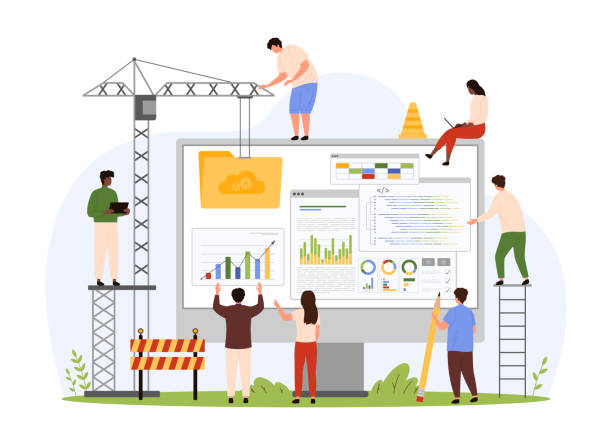
In the process of designing and managing an online store, there are some common mistakes that can be major obstacles to your success.
Understanding and preventing these mistakes can save you a lot of time and money.
One of the biggest mistakes is neglecting the mobile user experience. Given that a large percentage of purchases are made via mobile, a site not optimized for mobile will effectively lose a large portion of the market.
The solution? Responsive design and continuous testing of site performance on various devices.
Another mistake is complicating the checkout process. Every extra step or unnecessary information requested from the user can lead to cart abandonment.
Solution: Design the checkout process to be as simple, short, and visual as possible, and offer diverse payment options.
Insufficient investment in SEO is also a common error.
Even the best site is useless if it’s not visible in search results.
Solution: Integrate an SEO strategy into your e-commerce website design from the outset and continuously monitor and optimize it.
Lack of product information or low-quality images also drives customers away.
Customers cannot physically touch the product, so you must build trust by providing accurate information and attractive images.
Using comprehensive descriptions, technical specifications, and high-quality image galleries is essential.
Furthermore, the absence of efficient customer support can harm your brand’s reputation.
Not responding to questions or not resolving issues leads to customer dissatisfaction and loss.
Solution: A strong support system including online chat, phone, and email, and quick, professional responses.
By avoiding these mistakes, you can significantly increase your chances of success in the highly competitive world of e-commerce.
The Future of E-commerce Website Design and Emerging Trends

The world of e-commerce is constantly evolving, and e-commerce website design is no exception.
The future of online stores lies in embracing and integrating emerging trends that make the shopping experience more personal, immersive, and efficient.
One of the most important of these trends is the widespread use of Artificial Intelligence (AI) and Machine Learning.
AI can provide personalized product suggestions, precise recommendations, and even dynamic pricing by analyzing customer behavior data.
AI-powered chatbots can also offer 24/7 customer support and instant answers to frequently asked questions.
Augmented Reality (AR) and Virtual Reality (VR) are also changing how products are displayed.
Imagine a customer being able to virtually see furniture in their own home before purchasing, or trying on clothes on their 3D model.
These technologies help reduce return rates and increase purchase confidence.
Voice Commerce is also growing with the widespread adoption of voice assistants like Siri and Alexa. Optimizing a site for voice search means customers can make purchases using voice commands.
Sustainability and ethical practices are also becoming important factors for consumers.
Stores that emphasize product sustainability, eco-friendly packaging, and ethical business practices can gain a competitive advantage.
Ultimately, Subscription Models and Social Commerce experiences will also see increasing growth. Future e-commerce platforms must be able to easily incorporate these capabilities to provide a unique shopping experience tailored to modern customer needs.
Therefore, keeping pace with these trends in e-commerce website design is essential for maintaining competitiveness and success.
Frequently Asked Questions
| Row | Question | Answer |
|---|---|---|
| 1 | What is an e-commerce website? | It is a website that allows the online buying and selling of products or services, enabling users to view, select, and purchase products. |
| 2 | Why do we need e-commerce website design? | With an e-commerce website, businesses can reach a wider audience, operate 24/7, reduce operational costs, and increase their sales. |
| 3 | What are the main features of a successful e-commerce website? | Product catalog, shopping cart, secure payment gateway, order management system, user panel, product search and filter capabilities, and responsive design. |
| 4 | What are the common platforms for e-commerce website design? | Common platforms include WordPress (with WooCommerce plugin), Shopify, Magento, PrestaShop, or custom development (coding from scratch). |
| 5 | What is the importance of User Interface (UI) and User Experience (UX) in e-commerce website design? | Proper UI/UX design improves customer experience, reduces bounce rate, increases user engagement time on the site, and ultimately boosts conversion rates and sales. |
| 6 | What are the key stages of designing an e-commerce website? | These stages include planning and research, visual and UI design, technical development and coding, content entry, testing and debugging, launch, and support. |
| 7 | What is the importance of security in e-commerce websites? | Security is crucial for protecting sensitive user information (such as payment and personal data) and building customer trust. Using SSL certificates and secure payment gateways is essential. |
| 8 | What does SEO mean for an e-commerce website? | It means optimizing the site for search engines like Google so that product and category pages appear higher in search results and attract more organic (free) traffic. |
| 9 | What is the role of payment gateways in an e-commerce website? | A payment gateway is the bridge between the customer and the bank, enabling secure online financial transactions and transferring money from the customer’s account to the seller’s account. |
| 10 | What does Responsive Design mean for an e-commerce website? | It means that the e-commerce website should display correctly and be easy to use on any device (mobile, tablet, laptop) without losing information or experiencing layout issues. |
And other services of Rasaweb Advertising Agency in the field of advertising
Smart Marketing Automation: A fast and efficient solution for improving SEO rankings with a focus on marketing automation.
Smart Marketplace: Revolutionize click-through rates with custom programming.
Smart Website Development: A specialized service for increasing click-through rates based on marketing automation.
Smart Content Strategy: A professional solution for increasing sales with a focus on SEO-driven content strategy.
Smart Marketing Automation: Professional optimization for digital branding using attractive UI design.
And over hundreds of other services in internet advertising, advertising consultation, and organizational solutions
Internet Advertising | Advertising Strategy | Advertorials
Resources
Comprehensive Guide to E-commerce Website Design – Rayan HostComplete Guide to Online Store Website Design – Iran HostGuide to Successful and Professional E-commerce Website Design – Web24What is E-commerce Website Design and What are its Benefits? – Darj
✅? For your business’s leap in the digital world, Rasaweb Afarin Digital Marketing Agency, with years of experience in providing services such as e-commerce website design, SEO, and online advertising, paves your path to success.
📍 Tehran, Mirdamad Street, next to Bank Markazi, Kazerun Jonoubi Alley, Ramin Alley, No. 6

